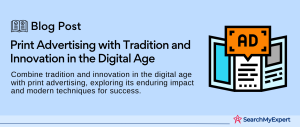Outdoor Advertising
Defining Outdoor Advertising
Outdoor advertising, also known as out-of-home (OOH) advertising, is a dynamic and influential form of marketing. It’s the art and science of reaching consumers while they are outside their homes. This form of advertising encompasses various mediums, including billboards, transit ads, and digital displays, strategically placed in high-traffic areas to maximize visibility and impact.
The Role in the Marketing Mix
In the marketing mix, outdoor advertising plays a pivotal role. It’s a powerful tool for building brand awareness and reinforcing messages from other channels. Unlike traditional media, outdoor advertising cannot be turned off or ignored, making it an essential element in integrated marketing strategies.
Evolving Landscape of Outdoor Advertising
The landscape of outdoor advertising is continually evolving, driven by technological advancements and changing consumer behaviors. Digitalization has revolutionized this space, allowing for dynamic content, interactive experiences, and targeted messaging. These innovations have transformed outdoor advertising from static displays into engaging platforms that capture the attention of passersby.
Unique Advantages Over Other Channels
Outdoor advertising holds unique advantages compared to other marketing channels:
- High Reach and Frequency: Billboards and transit ads are viewed by thousands daily, ensuring high visibility for your brand.
- Targeted Placement: Outdoor ads can be strategically placed to target specific demographics, locations, and times.
- Unskippable:
Unlike digital ads, outdoor ads can’t be blocked or skipped, ensuring your message is seen. - Brand Building:
Large, visually striking outdoor ads are effective in building brand recognition and loyalty. - Complementing Digital Efforts: Outdoor ads work in tandem with digital campaigns, reinforcing messages and increasing overall campaign effectiveness.
Outdoor advertising stands out for its ability to reach consumers on the go, in the real world, making a lasting impression that drives brand awareness and engagement.
Understanding Your Target Audience
Analyzing Target Demographics and Outdoor Behavior
Understanding your target audience’s demographics and outdoor behavior is crucial for effective outdoor advertising. Key factors to consider include:
- Age Group:
Different age groups respond to different types of messaging and visuals. - Interests and Preferences:
Tailoring your ad to align with the interests of your target audience increases relevance and engagement. - Commuting Patterns: Analyzing commuting patterns helps in placing ads where they are most likely to be seen by your target audience.
- Media Consumption Habits:
Understanding how your audience consumes media helps in determining the right mix of traditional and digital outdoor ads.
Identifying Effective Locations and Formats
Choosing the right locations and formats is critical for reaching your target audience:
- High-Traffic Areas:
Placing ads in busy streets, highways, and transit hubs ensures high visibility. - Location-Based Targeting:
Select locations frequented by your target demographic, such as near universities for young adults or business districts for professionals. - Choosing the Right Format: From traditional billboards to digital screens and transit ads, each format has its strengths and should be chosen based on your campaign objectives and audience preferences.
By thoroughly understanding your target audience and strategically placing your outdoor ads, you can effectively capture their attention and deliver impactful messages that resonate with their lifestyle and interests.
Message and Creative Development for Outdoor Advertising
Crafting Clear, Concise, and Impactful Messages
The essence of outdoor advertising lies in its ability to convey a message swiftly and effectively. Here are key aspects to consider:
- Brevity is Vital:
Your message should be short and easily digestible. The goal is to make an impact in seconds. - Resonance:
Tailor your message to resonate with the emotions and values of your target audience. - Simplicity:
Avoid clutter. The simpler the message, the stronger the impact.
Emphasizing Strong Visuals, Color, and Typography
Visual elements are the heartbeat of outdoor ads:
- Visual Impact:
Utilize striking images that capture attention and tell a story. - Color Schemes: Choose colors that evoke the right emotions and stand out in outdoor settings.
- Readability:
Select fonts that are easy to read from a distance and complement your design.
Adapting Creatives to Various Formats
Each outdoor format has its unique features:
- Billboards:
Ideal for bold visuals and simple messages. - Transit Ads: Consider the movement and context of the medium.
- Street Furniture: Offers opportunities for more detailed and interactive designs.
Choosing Strategic Locations and Formats
Exploring Different Formats and Their Strengths
It’s crucial to understand the strengths of various formats:
- Billboards: Offer high visibility and are ideal for wide-reaching campaigns.
- Transit Ads:
Reach a captive audience during commutes. - Street Furniture:
Engage pedestrians and locals in urban settings.
Analyzing Location Data and Audience Insights
Using data effectively can enhance your campaign’s impact:
- High-Traffic Areas:
Place your ads where they will be seen by the masses. - Target Audience Habits:
Understand where your target audience spends time and tailor your placements accordingly.
Considering Cost, Visibility, Dwell Time, and Creative Limitations
Each aspect plays a crucial role in decision-making:
- Cost: Align your choices with your budget.
- Visibility: Seek locations with high exposure.
- Dwell Time: Longer viewing times can increase message absorption.
- Creative Limitations: Adapt your design to the limitations and strengths of each format.
Integrating Outdoor with Your Marketing Mix
Creating a Cohesive Brand Experience
Integrating outdoor advertising into your marketing mix requires a harmonious approach:
- Consistent Messaging: Ensure your outdoor ads align with the tone, style, and message of your overall brand communication.
- Campaign Synergy: Outdoor ads should complement and amplify your campaigns across other channels, like TV, print, and digital.
Leveraging Immediacy and Reach
Outdoor advertising’s immediacy and broad reach can be powerful tools:
- Driving Online Engagement: Use outdoor ads to pique interest and drive audiences to your digital platforms.
- Social Media Integration: Incorporate social media elements in your outdoor ads, encouraging users to engage online.
Bridging Outdoor and Online Worlds
Interactive elements can create a seamless connection:
- QR Codes: Embed QR codes in your outdoor ads, leading to specific web pages, promotions, or digital experiences.
- Geofencing: Utilize geofencing to send targeted messages to consumers’ mobile devices when they are in proximity to your outdoor ads.
- Augmented Reality (AR):
AR can turn a standard billboard into an interactive experience, deepening engagement.
Tracking and Measuring Impact
Effective integration also involves tracking and analytics:
- Data Analysis:
Use data from online channels to understand how outdoor ads are influencing digital behavior. - Cross-Channel Metrics: Employ metrics that can track the journey from outdoor exposure to online engagement.
Adapting to Consumer Behavior
Understand and adapt to how your target audience interacts across different channels:
- Consumer Insights: Use insights about your audience’s media consumption habits to inform where and how you integrate outdoor and digital.
- Dynamic Content:
Tailor your outdoor content to reflect current trends, social media buzz, or even real-time data.
Integrating outdoor advertising into your broader marketing efforts isn’t just about placing ads alongside other channels. It’s about creating a unified, multi-dimensional strategy that leverages the unique strengths of outdoor advertising to complement and enhance your overall marketing narrative.
Measuring Success and Optimization in Outdoor Advertising
Defining Clear Objectives and KPIs
For a successful outdoor advertising campaign, it’s crucial to set defined objectives and key performance indicators (KPIs). These could include:
- Brand Awareness:
Tracking changes in brand recognition and recall. - Website Traffic:
Monitoring increases in site visits directly linked to the campaign. - Engagement Rates: Assessing social media and digital engagement driven by the campaign.
- Sales Conversion:
Measuring the direct impact on sales figures post-campaign.
Utilizing Data Analytics Tools and Audience Tracking
In the digital age, data analytics are indispensable:
- Traffic and Engagement Data: Collect and analyze data on the number of people exposed to the ads and their engagement levels.
- Digital Integration Analysis: For ads integrated with digital components like QR codes, track usage and follow-through rates.
- Audience Feedback: Use surveys and social media analytics to gauge audience reaction and engagement.
Analyzing Results and Identifying Areas for Improvement
Post-campaign analysis should focus on:
- Performance Review: Compare actual results against set KPIs to evaluate the campaign’s success.
- Consumer Insights:
Extract actionable insights from consumer feedback and engagement patterns. - Competitor Benchmarking:
Evaluate your campaign in the context of industry standards and competitors’ performance.
Optimizing Creatives and Locations
Use your findings to refine future campaigns:
- Creative Refinement:
Based on audience feedback, fine-tune messaging, visuals, and overall creative approach. - Location Optimization:
Shift to higher-performing locations or explore new areas based on traffic data and audience insights. - Format Experimentation:
Test different outdoor advertising formats to determine which resonates best with your audience.
By systematically defining objectives, employing data analytics, analyzing campaign performance, and continuously optimizing based on insights, businesses can significantly enhance the effectiveness and ROI of their outdoor advertising campaigns.
Emerging Trends and Future of Outdoor Advertising
Rise of Digital Outdoor Formats
The landscape of outdoor advertising is rapidly evolving with the introduction of digital formats:
- LED Screens: High-definition LED screens are replacing traditional billboards, offering dynamic, vivid advertising experiences.
- Interactive Displays: These incorporate touch screens, augmented reality (AR), or other interactive elements, engaging audiences in innovative ways.
The Role of Data and Technology
Data and technology are revolutionizing outdoor advertising:
- Precise Targeting:
Advanced data analytics enable advertisers to target specific demographics more accurately. - Real-Time Content: Digital screens can display content that changes based on time of day, audience composition, or even current events.
- Measurement and Analytics: New tools provide better insights into campaign performance, including audience reach and engagement.
Future Trends
Several trends are set to shape the future of outdoor advertising:
- Programmatic Outdoor Advertising:
Automated buying and selling of outdoor ad space, similar to digital advertising. - Integration with Mobile and Social Media:
Leveraging mobile data for targeting and integrating outdoor ads with social media campaigns for a multi-channel approach. - Sustainability in Outdoor Advertising:
Eco-friendly materials and energy-efficient digital displays are becoming increasingly important.
Conclusion
Despite the surge in digital media, outdoor advertising remains a critical component of marketing strategies:
- Unmatched Visibility: Its physical presence ensures high visibility and reach.
- Adaptability:
Outdoor advertising is continually adapting to incorporate digital innovations. - Complementing Digital Strategies: It effectively complements online and mobile marketing efforts.
Outdoor advertising is not only maintaining its relevance but also evolving to offer more personalized, engaging, and measurable experiences, making it an indispensable tool in the modern marketer’s arsenal.
Unleash your brand’s potential with innovative Advertising.
Table of Contents
Toggle






